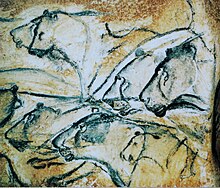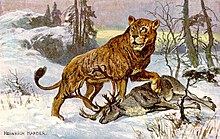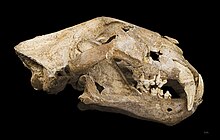Cave lion
| Cave lion | ||||||||||||
|---|---|---|---|---|---|---|---|---|---|---|---|---|

Skeleton of a cave lion in the Natural History Museum Vienna |
||||||||||||
| Temporal occurrence | ||||||||||||
| Middle Pleistocene to Upper Pleistocene | ||||||||||||
| 300,000 to 13,000 years | ||||||||||||
| Locations | ||||||||||||
| Systematics | ||||||||||||
|
||||||||||||
| Scientific name | ||||||||||||
| Panthera spelaea | ||||||||||||
| Goldfuss , 1810 | ||||||||||||
The cave lion ( Panthera spelaea , sometimes also Panthera leo spelaea ) is an extinct big cat that lived in Europe and North Asia during the Pleistocene . Originally seen as a more or less clearly delimited subspecies of the lion ( Panthera leo ), genetic findings speak for an independent species. The first description was made by the doctor and naturalist Georg August Goldfuss on the basis of a skull from the zoolite cave of Burggaillereuth near Muggendorf in the Franconian Jura .
Geographical and temporal distribution

In Europe, lions first appeared with Panthera fossilis , the so-called Mosbacher lion , about 700,000 years ago. The fact that these Mosbacher lions are sometimes referred to as cave lions can cause confusion. Here, the term cave lion is understood exclusively to mean Panthera spelaea . The origin of the cave lion is not clear. Probably both, Höhlenlöwe and Mosbacher Löwe, are closely related to each other. Due to individual "tigrin" characteristics, for example in the structure of the skull, both forms can possibly be traced back to the more Asian-Eastern European Panthera gombaszoegensis . The cave lion was first documented about 300,000 years ago in the late Middle Pleistocene . The cave lion was widespread across northern Eurasia and penetrated far north even during the cold ages. He also reached Alaska via the Bering Land Bridge , which had fallen dry due to the icing . From there it probably pushed further south and evolved into the American lion ( Panthera atrox ). The cave lion disappeared at the end of the last glacial period around 12,000 years ago, but possibly persisted on the Balkan Peninsula well into the post-ice age. In the case of these lions, which apparently still lived in the Balkans at the turn of the century, it is not clear whether they actually belonged to the subspecies of the cave lion. The most recent reliable records of cave lions from the Lena River area in Siberia and from Sigmaringen in Germany are dated to an age of around 12,500 carbon years using radiocarbon dating (the absolute age in calendar years is slightly higher).
Cave lion fossil finds often come from caves where their carcasses are often dragged in by hyenas . Such caves in Germany are the Bilsteinhöhle that Balver cave that Perick cave system that Kepplerhöhle and Zoolithenhöhle . A complete skeleton of a cave lion outside a cave is known from Siegsdorf in Bavaria, which was found in 1985. A nearly complete skeleton of a lioness with pathological changes was discovered in Neumark-Nord in the Geiseltal . Another complete cave lion skeleton was found in the Srbsko Chlum – Komín cave in the Czech Republic.
Appearance

Adult cave lions exceeded today's lions on average by 5 to 10% in body size, but this does not apply to all skeletal elements. Body size calculations are available for some finds from the Rhine area. For example, a head-trunk length of 217 cm was determined for an approximately 37 cm long shin from Hessenaue, and a body length of 206 cm for an approximately 34 cm long shin from Geinsheim. A thigh bone about 37 cm long from Groß-Rohrheim leads to a head-trunk length of 194 cm. They did not reach the significantly larger dimensions of the Mosbacher lions ( Panthera fossilis ) and the American lions ( Panthera atrox ).
Conclusions about the fur and mane of the cave lion can be drawn from Stone Age cave paintings and carvings. The color pictures of the Chauvet cave in the Ardèche department in southern France and the ivory carving of a hybrid of lion and human (known as the lion man ) from the Hohlenstein barn on the Swabian Alb in southern Germany show particularly impressive lions . Stone Age depictions (e.g. in the Chauvet Cave and the carving of the lion man) always show cave lions without a mane, which indicates that male cave lions, in contrast to their African and Indian relatives, were maneless. These representations, however, often have the tail tassel typical of lions. According to these drawings, the fur seems to have been one color.
Way of life

Lions populated Europe and North Asia in both the warm and cold periods . In Central Europe , the cave lions also occurred during maximum glaciation. Fossil footsteps of cave lions, which have been preserved alongside those of reindeer , show that these cats have penetrated at least into subpolar zones . Their diet consisted mainly of larger ungulates of the time, such as wild horses , deer , wild cattle and antelopes . The shin of a cave lion was found in the Lower Pleistocene deposits of the Rhine from Hessenaue near Darmstadt, which later healed despite a severe inflammation of the bone marrow that temporarily made the animal incapable of hunting. The animal must therefore have survived with this disability for a long time. This suggests that this animal was tolerated by conspecifics on the prey or provided with food. It is possible that the cave lion was a pack animal, similar to today's lions.
Despite its name, the cave lion was not a distinct inhabitant of caves. In contrast to the cave hyena and the cave bear , he probably only rarely visited caves as hiding places. Especially sick, old or weakened cave lions probably sought protection here and perished. Also, in some cases, complete lion carcasses were dragged into caves by cave hyenas. Their cubs do not appear to have raised cave lions in caves, unlike cave bears or hyenas. This can be seen from the few finds of young lions in caves and the lack of lion's milk teeth. Similar to today's lions, cave lions do not seem to have hidden their prey in caves either, unlike hyenas.
relationship
|
External relationship of the cave lion according to Tseng et al. 2014
|
|
Internal relationship of the cave lion according to Stanton et al. 2020
|
Unlike the Mosbach lion ( Panthera fossilis ), the cave lion has long been disputed as to whether it belongs to the tiger ( Panthera tigris ) or the lion ( Panthera leo ) or whether it is a species of its own. In 2004, German scientists succeeded in using a DNA test to identify the cave lion as a subspecies or at least as a very close relative of the lion ( Panthera leo ). This has since been confirmed, which has clarified a dispute that has existed since the first description in 1810 as to whether the fossils are the remains of a lion or a tiger. Nevertheless, the Pleistocene lions of the north form their own line, which the lions of Africa and South Asia face. This so-called spelaea group includes the Mosbach lion, the cave lion and the American lion ( Panthera atrox ). All lions today belong to the leo group. The cave lion lineage evolved in isolation from that of the African and Asiatic lions for at least 600,000 years. However, there is a larger split within the cave lion with two larger clades . One, Clade C , populated most of Eurasia. Another genetically closely related group is in Eastern Siberia and Beringia limited, it is used as a clade B , respectively. The animals also differ morphologically from the other cave lions due to their smaller size. Sometimes they are therefore also regarded as a separate subspecies ( P. s. Vereshchagini ). Both lines separated genetically about 578,000 years ago, during the Middle Pleistocene . A third group, currently only represented by an individual from Eastern Siberia and highlighted as Clade A , had split off in the Old Pleistocene around 971,000. In contrast, there are relatively clear genetic differences between American lions south of the glacial ice sheets on the one hand and Eurasian or Beringia cave lions on the other. Further genetic studies from 2016 shifted the separation of the spelaea and leo groups back to around 1.89 million years, which justifies the cave lion's independence at species level. The different results of the individual genetic analyzes are attributed to deviating calibration models, as the older studies in particular took the “detour” via absolute dating of the Mosbacher lion. This was confirmed in another study from 2020. However, a study published at the same time estimates the separation of the cave lion and today's lion at only 500,000 years.
Ice mummies

In the summer of 2015, the Academy of Sciences of Yakutia in the Russian Republic were, according to Sacha , in Rajon Abyysky District on the banks of the river Uyandina River discovered the perfectly preserved Eismumien two pups. The finds are in an extraordinarily good state of preservation and were presented to the public in November 2015. The age of the ice mummies was first dated to at least 12,000 years, with an age of about four weeks. Recent studies indicate an age of 1–2 weeks and a possible preservation period of up to 55,000 years. The two puppies were named "Uyan" and "Dina". A large amount of a white liquid was found in Uyan's stomach, possibly breast milk. In order not to contaminate the liquid, it has not been removed so far (as of 2017). The investigation by Yakut, Russian, US, German, Japanese and South Korean scientists is still ongoing and is expected to take a total of three years.
At the beginning of 2017, the Academy of Sciences of Yakutia announced the discovery of another approximately 50,000-year-old specimen of an ice mummy of a young animal. The specimen found on the banks of the Tirekhtykh River, also in Abyjski ulus in September 2016, is in almost perfect condition, weighs 4 kilograms, 45 centimeters long and was preserved between 1½ and 2 months of age.
literature
- Alan Turner: The big cats and their fossil relatives. Columbia University Press, New York NY 1997, ISBN 0-231-10229-1 .
- Wighart von Koenigswald : Living Ice Age. Climate and fauna in transition. Theiss-Verlag, Stuttgart 2002, ISBN 3-8062-1734-3 .
- Joachim Burger, Wilfried Rosendahl, Odile Loreille, Helmut Hemmer, Torsten Eriksson, Anders Götherström, Jennifer Hiller, Matthew J. Collins, Timothy Wess, Kurt W. Alta: Molecular phylogeny of the extinct cave lion Panthera leo spelea. In: Molecular Phylogenetics and Evolution. 30, 2004, ISSN 1055-7903 , pp. 841-849, ( online PDF; 196 kB ).
- Cajus Diedrich : Field finds of the Upper Pleistocene cave lion Panthera leo spelaea Goldfuss 1810 in Westphalia (Northern Germany) . In: Philippia. 11, 3, 2004, ISSN 0343-7620 , pp. 219-226.
- Ernst Probst : cave lions. Big cats in the Ice Age. GRIN publishing house for academic texts, Munich et al. 2009, ISBN 978-3-640-27263-1 .
Web links
- UNESCO World Heritage in the Museum of the University of Tübingen MUT: press information, photos and 3D animations of the objects ; In: www.unimuseum.de, Eberhard Karls University of Tübingen, Museum of the University of Tübingen MUT
Individual evidence
- ^ A b Karlheinz Fischer: A lion skeleton (Panthera spelaea, Goldfuß, 1810) from the interglacial sediments of the Saale period from Neumark-Nord near Merseburg. Dietrich Mania et al. (Ed.): Neumark-Nord - An interglacial ecosystem of the Middle Paleolithic people. Publications of the State Museum for Prehistory in Halle 62. Halle / Saale, 2010, pp. 339–360.
- ↑ a b c d R. Barnett, B. Shapiro, I. Barnes, SY Ho, J. Burger, N. Yamaguchi, TF Higham , HT Wheeler, W. Rosendahl, AV Sher, M. Sotnikova, T. Kuznetsova, GF Baryshnikov, LD Martin, CR Harington, JA Burns, A. Cooper: Phylogeography of lions (Panthera leo ssp.) Reveals three distinct taxa and a late Pleistocene reduction in genetic diversity. In: Molecular ecology. 18 (8), 2009, pp. 1668-1677, doi : 10.1111 / j.1365-294X.2009.04134.x , PMID 19302360 .
- ↑ a b Cajus G. Diedrich: Steppe lion remains imported by Ice Age spotted hyenas into the Late Pleistocene Perick Caves hyena den in northern Germany. In: Quaternary Research. 71 (3), 2009, pp. 361-374.
- ^ Cajus G. Diedrich: A diseased Panthera leo spelaea (Goldfuss 1810) lioness from a forest elephant graveyard in the Late Pleistocene (Eemian) interglacial lake at Neumark-Nord, central Germany. In: Historical Biology. 23 (2-3), 2011, pp. 195-217, doi: 10.1080 / 08912963.2010.507814 .
- ^ CG Diedrich, K. Zak: Prey deposits and den sites of the Upper Pleistocene hyena Crocuta crocuta spelaea (Goldfuss, 1823) in horizontal and vertical caves of the Bohemian Karst (Czech Republic). In: Bulletin of Geosciences. 81, 4, 2006, pp. 237-276.
- ↑ Martina Pacher: Finds of the cave lion (Panthera leo spelaea) from the Herdengelhöhle (1823/4) near Lunz am See, Lower Austria. In: The cave. 60 (1-4), 2009, pp. 21-27
- ↑ a b Wighart von Koenigswald and Erich Schmitt: A pathologically changed lion tibia from the Young Pleistocene of the northern Upper Rhine plain. In: Nature and Museum. 117 (9), 1987, pp. 272-277.
- ^ Z. Jack Tseng, Xiaoming Wang, Graham J. Slater, Gary T. Takeuchi, Qiang Li, Juan Liu and Guangpu Xie: Himalayan fossils of the oldest known pantherine establish ancient origin of big cat. In: Proceedings of the Royal Society B. 281 (1774), 2014, S. 20132686, doi: 1098 / rspb.2013.2686
- ↑ a b c David WG Stanton, Federica Alberti, Valery Plotnikov, Semyon Androsov, Semyon Grigoriev, Sergey Fedorov, Pavel Kosintsev, Doris Nagel, Sergey Vartanyan, Ian Barnes, Ross Barnett, Erik Ersmark, Doris Döppes, Mietje Germonpré, Michael Hofreiter, Wilfried Rosendahl, Pontus Skoglund and Love Dalén: Early Pleistocene origin and extensive intra-species diversity of the extinct cave lion. In: Scientific Reports. 10, 2020, p. 12621, doi: 10.1038 / s41598-020-69474-1 .
- ↑ a b Joachim Burger, Wilfried Rosendahl, Odile Loreille, Helmut Hemmer, Torsten Eriksson, Anders Götherström, Jennifer Hiller, Matthew J. Collins, Timothy Wess, Kurt W. Alt: Molecular phylogeny of the extinct cave lion Panthera leo spelaea. In: Molecular Phylogenetics and Evolution. 30 (3), 2004, pp. 841-849.
- ↑ Gennady Baryshnikov and Gennady Boeskorov: The pleistocene cave lion, Panthera spelaea (Carnivora, Felidae) from Yakutia, Russia. In: Cranium. 18 (1), 2001, pp. 7-24.
- ↑ Ross Barnett, Marie Lisandra Zepeda Mendoza, André Elias Rodrigues Soares, Simon YW Ho, Grant Zazula, Nobuyuki Yamaguchi, Beth Shapiro, Irina V Kirillova, Greger Larson, M Thomas P Gilbert: Mitogenomics of the Extinct Cave Lion, Panthera spelaea (Goldfuss , 1810), Resolve its Position within the Panthera Cats. In: Open Quaternary. 2, 2016, p. 4, doi: 10.5334 / oq.24 .
- ↑ Marc de Manuel, Ross Barnett, Marcela Sandoval-Velasco, Nobuyuki Yamaguchi, Filipe Garrett Vieira, M. Lisandra Zepeda Mendoza, Shiping Liu, Michael D. Martin, Mikkel-Holger S. Sinding, Sarah ST Mak, Christian Carøe, Shanlin Liu , Chunxue Guo, Jiao Zheng, Grant Zazula, Gennady Baryshnikov, Eduardo Eizirik, Klaus-Peter Koepfli, Warren E. Johnson, Agostinho Antunes, Thomas Sicherheitsitz-Ponten, Shyam Gopalakrishnan, Greger Larson, Huanming Yang, Stephen J. O'Brien, Anders J. Hansen, Guojie Zhang, Tomas Marques-Bonet and M. Thomas P. Gilbert: The evolutionary history of extinct and living lions. In: PNAS. 117 (20), 2020, pp. 10927-10934, doi: 10.1073 / pnas.1919423117 .
- ↑ The Siberian Times - Whiskers still bristling after more than 12,000 years in the Siberian cold (November 17, 2015)
- ↑ The Siberian Times - Extinct lion cubs found in Siberia are up to 55,000 years old - latest test results reveal (November 11, 2016, accessed February 5, 2018)
- ↑ The Siberian Times - Scientists may have discovered 12,000 year old mother's milk, frozen in permafrost (March 21, 2016, accessed February 5, 2018)
- ↑ The Siberian Times - Extinct cave lion cub in 'perfect' condition found in Siberia rising cloning hopes (November 9, 2017, accessed February 5, 2018)
